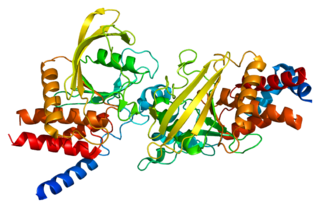Related Research Articles

Lipoprotein lipase (LPL) (EC 3.1.1.34, systematic name triacylglycerol acylhydrolase (lipoprotein-dependent)) is a member of the lipase gene family, which includes pancreatic lipase, hepatic lipase, and endothelial lipase. It is a water-soluble enzyme that hydrolyzes triglycerides in lipoproteins, such as those found in chylomicrons and very low-density lipoproteins (VLDL), into two free fatty acids and one monoacylglycerol molecule:

Chromosome 1 is the designation for the largest human chromosome. Humans have two copies of chromosome 1, as they do with all of the autosomes, which are the non-sex chromosomes. Chromosome 1 spans about 249 million nucleotide base pairs, which are the basic units of information for DNA. It represents about 8% of the total DNA in human cells.

fChromosome 9 is one of the 23 pairs of chromosomes in humans. Humans normally have two copies of this chromosome, as they normally do with all chromosomes. Chromosome 9 spans about 150 million base pairs of nucleic acids and represents between 4.0 and 4.5% of the total DNA in cells.
The Hedgehog signaling pathway is a signaling pathway that transmits information to embryonic cells required for proper cell differentiation. Different parts of the embryo have different concentrations of hedgehog signaling proteins. The pathway also has roles in the adult. Diseases associated with the malfunction of this pathway include cancer.

Angiopoietin is part of a family of vascular growth factors that play a role in embryonic and postnatal angiogenesis. Angiopoietin signaling most directly corresponds with angiogenesis, the process by which new arteries and veins form from preexisting blood vessels. Angiogenesis proceeds through sprouting, endothelial cell migration, proliferation, and vessel destabilization and stabilization. They are responsible for assembling and disassembling the endothelial lining of blood vessels. Angiopoietin cytokines are involved with controlling microvascular permeability, vasodilation, and vasoconstriction by signaling smooth muscle cells surrounding vessels. There are now four identified angiopoietins: ANGPT1, ANGPT2, ANGPTL3, ANGPT4.

Angiopoietin 1 is a type of angiopoietin and is encoded by the gene ANGPT1.

Angiopoietin-2 is a protein that in humans is encoded by the ANGPT2 gene.

Angiopoietin-1 receptor also known as CD202B is a protein that in humans is encoded by the TEK gene. Also known as TIE2, it is an angiopoietin receptor.

Angiopoietin-like 4 is a protein that in human is encoded by the ANGPTL4 gene. Alternatively spliced transcript variants encoding different isoforms have been described. This gene was previously referred to as ANGPTL2, HFARP, PGAR, or FIAF but has been renamed ANGPTL4.

Receptor-type tyrosine-protein phosphatase beta or VE-PTP is an enzyme specifically expressed in endothelial cells that in humans is encoded by the PTPRB gene.

Angiopoietin-related protein 1 also known as angiopoietin-3 (ANG-3) is a protein that in humans is encoded by the ANGPTL1 gene.

Angiopoietin-like 3, also known as ANGPTL3, is a protein that in humans is encoded by the ANGPTL3 gene.

Angiopoietin-4 is a protein that in humans is encoded by the ANGPT4 gene.

Angiopoietin-related protein 7 is a protein that in humans is encoded by the ANGPTL7 gene.

Fibrinogen-like protein 1 (FGL-1) is a protein that is structurally related to fibrinogen. In humans, FGL-1 is encoded by the FGL1 gene. Four splice variants exist for this gene.

Angiopoietin-related protein 2 also known as angiopoietin-like protein 2 is a protein that in humans is encoded by the ANGPTL2 gene.

E74-like factor 2 (ELF2), formerly known as new Ets-related factor (NERF), is an ETS family transcription factor. In humans this protein is encoded by the ELF2 gene.

ANGPTL8 is a protein that in humans is encoded by the C19orf80 gene.

Glycosylphosphatidylinositol anchored high density lipoprotein binding protein 1 (GPI-HBP1) also known as high density lipoprotein-binding protein 1 is a protein that in humans is encoded by the GPIHBP1 gene.
Evinacumab, sold under the brand name Evkeeza, is a monoclonal antibody medication for the treatment of homozygous familial hypercholesterolemia (HoFH).